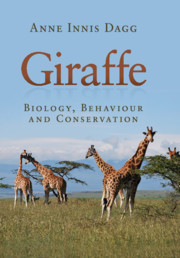Book contents
- Frontmatter
- Dedication
- Contents
- Preface
- Acknowledgements
- List of abbreviations
- 1 Time-line of giraffe
- 2 The giraffe’s environment
- 3 Feeding in the wild
- 4 Social behaviour and populations
- 5 Individual behaviours
- 6 External features
- 7 Anatomy
- 8 Physiology
- 9 Pregnancy, growth, reproduction and aging
- 10 Giraffe in zoos
- 11 Status and conservation of giraffe races
- Appendix Parasites and pathogens
- References
- Index
2 - The giraffe’s environment
Published online by Cambridge University Press: 05 February 2014
- Frontmatter
- Dedication
- Contents
- Preface
- Acknowledgements
- List of abbreviations
- 1 Time-line of giraffe
- 2 The giraffe’s environment
- 3 Feeding in the wild
- 4 Social behaviour and populations
- 5 Individual behaviours
- 6 External features
- 7 Anatomy
- 8 Physiology
- 9 Pregnancy, growth, reproduction and aging
- 10 Giraffe in zoos
- 11 Status and conservation of giraffe races
- Appendix Parasites and pathogens
- References
- Index
Summary
Over millions of years, evolution and the environment shaped the lives of the giraffids that lived in Africa. However, giraffids also helped to shape their surroundings. This chapter deals with environmental changes caused by nature and giraffe which have a hierarchy of importance:
(a) large-scale natural changes that can affect a huge area, using the Serengeti ecosystem in Tanzania as an example;
(b) mid-scale changes caused by giraffe living in areas within this ecosystem;
(c) changes induced on single trees by the foraging of giraffe; and
(d) changes to the giraffe’s environment caused by human management (interference).
Large-scale changes in the Serengeti ecosystem
Giraffe search out habitats of trees and bushes where they can obtain sufficient browse for their needs, yet have enough open space so they can make a quick getaway should lions attack. Such wooded savannah areas occur in many parts of Africa, perhaps none more famous for its giraffe than the huge (nearly 11,000 km2) Serengeti ecosystem. The recent history of the Serengeti demonstrates how radically vegetation (and therefore food sources) can change. Robin Pellew (1983c), now a prominent citizen of London with an OBE, describes three major events that made this environment especially attractive to Masai giraffe in the late 1970s:
(a) elephant invasions into the Serengeti Park, upending trees and destroying bushes while foraging;
(b) the end of a rinderpest epidemic in the mid 1960s, so that wildlife could again live and reproduce rather than possibly die of disease; and
(c) unexpected rainfalls in the ‘dry season’ which were (are) always welcome.
- Type
- Chapter
- Information
- GiraffeBiology, Behaviour and Conservation, pp. 16 - 23Publisher: Cambridge University PressPrint publication year: 2014



